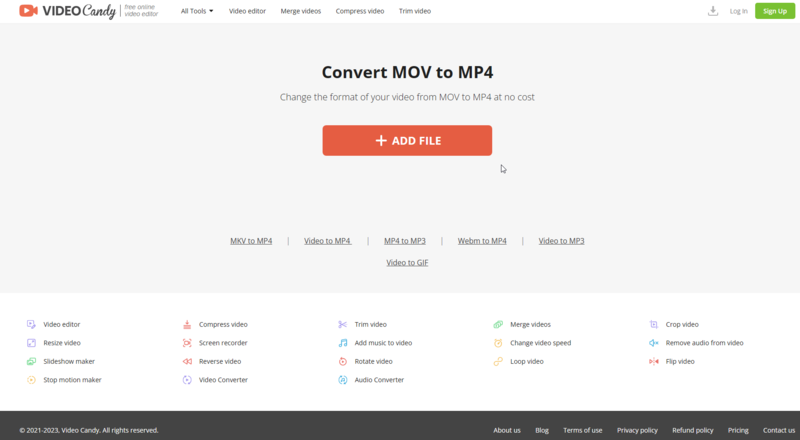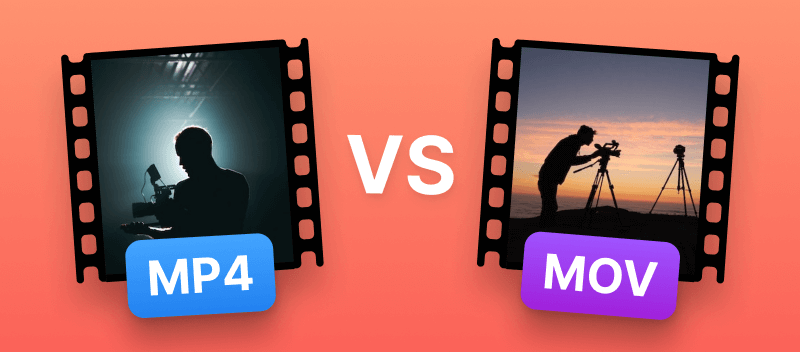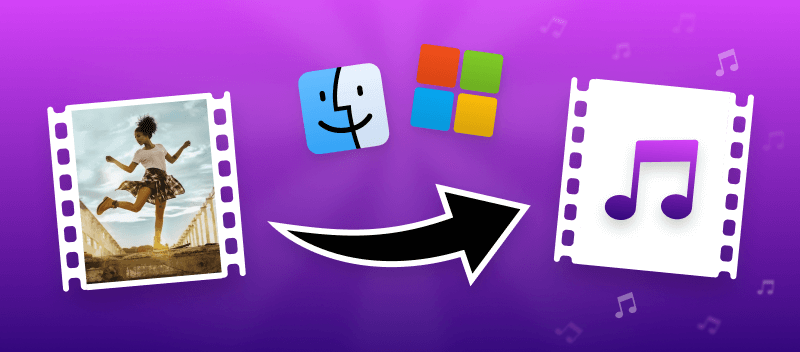In the ever-evolving landscape of digital media, the choice of file format plays a pivotal role in determining the quality, compatibility, and overall user experience. Among the myriad options available, MP4 and MOV formats stand out as two widely used, each with its unique set of features and advantages.
If you find yourself pondering the question, "Which one should I use: MP4 or MOV?", you've come to the right place. We'll explain the differences between the MP4 and MOV and help to decide which one is right for your needs.
So let's dive into the MP4 vs MOV battle!
What is MP4 format?
MP4 is a digital video format developed by the Moving Picture Experts Group (MPEG). It is a container that stores audio, video, and text data in a single file. MP4 was first released in 2001 and has since become one of the most popular formats.
The development of MP4 began in 1998, when MPEG, an international group of experts in audio and video technologies, started working on the project. The group was led by two German engineers - Fraunhofer Institute's Thomas Ziegler and Moving Picture Expert Group's Matthias Rose.
Today, the MP4 extension is used by various online streaming services such as YouTube, Netflix, and Hulu. It is also supported by many devices like smartphones, tablets, desktop players, gaming consoles, and more. Thanks to its high video compression rate and compatibility with different platforms, it is definitely among the most well-known formats for digital media.
Codecs for MP4
- H.264 (Advanced Video Coding, AVC) offers efficient compression while maintaining relatively high-quality video playback. It's universally integrated with almost all modern devices, browsers, and platforms.
- H.265 (High Efficiency Video Coding, HEVC) has improved compression efficiency, resulting in smaller file sizes for the same quality level. However, it may not be as universally supported as H.264, especially on older devices and browsers.
- AAC (Advanced Audio Coding) provides high-quality compression with relatively small file sizes, making it suitable for streaming and multimedia applications.
- MP3 (MPEG Audio Layer III) is still sometimes used as a codec in MP4 files, particularly for compliance with legacy devices and software.
What is a MOV file?
MOV video file format created by Apple. It was introduced as the default extension for QuickTime, an application used to play files on macOS. MOV format uses the same compression technology as other QuickTime formats, such as MP4 and 3GP. This way they can be easily shared across devices and platforms.
MOV extension is known for its ability to store high-quality multimedia, which makes it ideal for stocking movies, music videos, and other large files. They can also be used to keep text information, such as subtitles or chapter titles.
QuickTime remains the best way to play MOV files on Apple computers. However, there are also many third-party media players available for Windows and other platforms.
Codecs for MOV
- H.264 (Advanced Video Coding, AVC) is commonly used in MOV files for its efficient compression and widespread compatibility.
- Apple ProRes is a high-quality, lossy video compression employed in professional production workflows on macOS and within Apple's ecosystem.
- Apple Intermediate Codec (AIC) was developed for professional editing and post-production.
- AAC (Advanced Audio Coding) enables superior sound compression with efficient file sizes, making it well-suited for various audiovisual applications.
Difference between MP4 and MOV: summary table
MOV and MP4 are the two most common video file types used today. These formats use a container format to store video and audio data, but there is a key difference between them.
| Feature | MP4 Format | MOV Format |
|---|---|---|
| Developer. | MPEG (Moving Picture Experts Group). | Apple Inc. |
| Compatibility. | Supported on various platforms. | Initially associated with Apple, but can be opened on both macOS and Windows. |
| Usage. | Used for online streaming, sharing, and storage. | Widely used in the Apple ecosystem, popular for video editing and playback. |
| Quality. | Efficient compression, balances file size and quality. | Can maintain high-quality video and audio. |
| Editing. | Compatible with video editing software. | Preferred for editing on Mac, supports multiple tracks of audio, video, and text. |
| File size. | Smaller file sizes. | May result in larger file sizes. |
Benefit from both types
MP4 vs MOV - the choice mainly depends on the type of media being shared.
If, say, you're sharing a video of a lecture, webinar, or business presentation, MP4 format is probably your best bet. That's because it offers high compatibility with a variety of platforms and devices.

On the contrary, if you need to share a video that requires higher quality and more advanced editing features, the MOV format is likely the better option thanks to its support for larger frame sizes and greater color fidelity.
Ultimately, these video formats provide advantages depending on the situation and it’s important to understand when each one should be used.
List of apps that can play MOV and MP4 files
- VLC Media Player;
- QuickTime Player;
- Windows Media Player;
- iTunes;
- MPC-HC;
- KMPlayer;
- RealPlayer;
- 5KPlayer.
List of programs for editing MOV and MP4 files
- Icecream Video Editor;
- Adobe Premiere Pro;
- DaVinci Resolve;
- iMovie;
- Shotcut;
- Aiseesoft;
- Avidemux;
- Filmora.
Troubleshooting common issues: table
| Problem | MP4 | MOV |
|---|---|---|
| Playback | Update the media player to ensure compatibility with the format. | Install QuickTime or try an alternative software for better support. |
| Audio/Video Sync | Re-encode using a reliable converter to correct the mismatch. | Ensure software is up-to-date, and realign audio/video in the editor. |
| Corrupted Files | Use repair tools like VLC or specific recovery software. | Attempt conversion to another format to retrieve the content. |
| Incompatible Devices/Platforms | Convert to a more universally supported format like MOV or WebM. | Utilize QuickTime on macOS or change to MP4 for broader accessibility. |
| Slow Playback | Lower video bitrate or compress to enhance performance. | Convert to a codec like H.264 for smoother playback. |
| File Won’t Open | Check for missing codecs by updating the media player. | Install the latest QuickTime version or use a third-party app. |
MP4 vs MOV: FAQs
1. Are there significant differences in video quality between MP4 and MOV?
A: Both of them are capable of maintaining high-quality video. However, the level of compression applied and the resulting file size may vary. MOV files might retain higher quality, making them suitable for professional video production.
2. Which format is better for streaming?
A: MP4 is commonly preferred for online streaming due to its efficient compression. Many online platforms, including YouTube and Vimeo, use MP4 for streaming videos.
3. Do MP4 and MOV have any differences in terms of subtitle support?
A: Both MP4 and MOV formats support subtitles, allowing for the inclusion of text data within the multimedia container.
4. Can I play both files on mobile devices?
A: Yes, MP4 and MOV files are compatible with a wide range of mobile devices, including smartphones and tablets. Operating systems, such as iOS and Android, have built-in support for these formats, ensuring playback on phones.
5. Which format is more commonly used by professionals?
A: MOV is often preferred in the professional sphere, especially in the film and television industry, due to its ability to maintain higher video and audio quality. However, the choice between MP4 and MOV may also depend on the workflow and requirements of the production.
6. Can MP4 and MOV be used for storing and playing high dynamic range (HDR) content?
A: Yes, both formats support HDR content, allowing users to enjoy enhanced contrast, brightness, and color representation in videos. HDR capabilities make MP4 and MOV suitable for delivering a more immersive visual experience.
MP4 vs MOV: Summary
In conclusion, determining whether MP4 or MOV is better ultimately hinges on the specific needs and objectives of the user. MP4 extension, with its widespread support, efficient compression, and versatility, emerges as a reliable choice for streaming, sharing, and storage across diverse platforms.
Meanwhile, MOV format, deeply rooted in the Apple ecosystem, shines in professional video production and editing, offering uncompromised quality and seamless integration with QuickTime.
If needed, converting MOV to MP4 can be seamlessly accomplished using reliable video conversion tool, ensuring compatibility across various devices and platforms.




